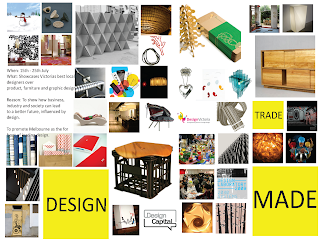
Wednesday, June 3, 2009
Sunday, May 31, 2009
Can it hold?
SOLUTION:
The 1:1 scale proved that my stool can withstand the weight of a person.....me.
PROBLEM 2:
In the pictures below you can see some tearing at the corners where the stress is very high.
SOLUTION:
I have managed to solve this by ensuring there are some strees relief cuts at each corner.
PROBLEM 3:
Locking sytems?
SOLUTION:
A simple mortice and tennon joint running along each leg holds the stool in place.
Tuesday, May 26, 2009


Sunday, May 17, 2009
Tuesday, May 5, 2009

The original design has a fair amount of strength thanks to the inner pyrimid. The problem that next needs to be focused on is the inner triangle that folds under the seat. When the user is sitting on the stool there is a chance that the undersides may loose there rigidity. To solve this, the unused triangles will be extended to fix to the outer pyrimid faces. When the user sits on the stool, their weight is exhausted on these triangles which then passes the force onto the Pyrimid.

One possible outcome for the bar stool is to allow Graffiti artists to use the space and express their work on the stool. This outcome will add to a political, emotional or important statement adding more value to the design sense of the stool.
The Grafitti on the above stool is by Toby Caves, heavily influenced by music and design. His works have appeared all over the world in International design fairs and Grafitti Art exhibitions.
Monday, May 4, 2009

This image shows us how strong Xanita board actually is. From this image, the stools only seem to utilize three pieces of Xanita to form a strong sturdy stool.
Sourced: www.Xanita.com

Here is a series of timber joinery methods. Considering the concept stool has an edge meeting a face, we would consider that a butt joint of some kind would be acceptable to utilize. However, the problem that is faced, is that the edge and the face want to pull away from each other, therefore a locking system, such as a dovetail joint may be acceptable.

Sunday, May 3, 2009
Structure:
When the product is folded to create the stool, running down the centre is an open pyrimid which stabalizes the stool. The "flaps" that are running from the triangles as seen on the flat pattern are positioned in a way that when folded seem to run into each other, thus creating this centre pyrimid.
The two other triangles, seen floating next to the flaps or "runners" tuck underneath the stools top, creating a stronger area where the user will exhaust most of their weight.
Aesthetics:
A unique approach to stability. The stool seems as though it is unbalanced given that the runner flaps are positioned on an angle to the x and y axis of the stool. Given this, the stool is very stable as the base of the pyrimid forms a square.










































